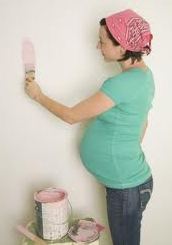April 13th, 2011 by Linda Burke-Galloway, M.D. in News, Opinion
No Comments »

 This post is written as a follow-up to The Hijacking of Pregnant Women.
This post is written as a follow-up to The Hijacking of Pregnant Women.
It is said that sometimes you have to rock the boat in order to shift the course of progress. Well today pregnant women have reason to celebrate. The winds of change are apparent.
Bowing under pressure, K-V Pharmaceutical Company reduced the price of Makena from $1500 to $690. Makena is the trade name for hydroxyprogesterone caproate or 17OHP. It is a drug recently approved by the Federal Drug Administration (FDA) to reduce premature deliveries before 37 weeks if it is given before 21 weeks gestation. It has been used for years as an off-label drug and costs approximately $10 to $20 to make by compound pharmacists. When the FDA gave K-V an exclusive right to manufacture the drug, their integrity flew out the window. The pricing strategy of K-V is a case study of corporate greed. Most drug companies will use the “research and development” logic to explain their rationale for marking up the cost of a drug. In the case of Makena, that excuse is valid. The research and development of Makena had already been done by Squibb Pharmaceuticals who had sold the drug for years. Is it any wonder why U.S. citizens will cross geographic borders and purchase drugs from their Canadian and Mexican neighbors?
Kudos are in order to the American College of Obstetricians and Gynecologists (ACOG) who took the lead in questioning K‑V’s pricing strategies. Read more »
*This blog post was originally published at Dr. Linda Burke-Galloway*
March 28th, 2011 by Linda Burke-Galloway, M.D. in Health Tips, News
No Comments »

 Periodically, the FDA publishes drug warnings that should be shared with the public, especially if it affects pregnant women. Each year, over 4 million babies are born in the US and 43% will continue to be breast fed at 6 months. All of these moms will invariably use meds at some point after birth, so which meds are helpful and which are potentially harmful? These questions may now be answered by the Infant Risk Center, at the Texas Tech University Health Center, in Amarillo, Texas. This center provides up-to-date information regarding the safety of medications that are taken both during pregnancy and after birth.
Periodically, the FDA publishes drug warnings that should be shared with the public, especially if it affects pregnant women. Each year, over 4 million babies are born in the US and 43% will continue to be breast fed at 6 months. All of these moms will invariably use meds at some point after birth, so which meds are helpful and which are potentially harmful? These questions may now be answered by the Infant Risk Center, at the Texas Tech University Health Center, in Amarillo, Texas. This center provides up-to-date information regarding the safety of medications that are taken both during pregnancy and after birth.
Most drugs enter breast milk immediately after birth and during the first 4 to 10 days of life at a fairly fast rate based on the physiology of breast cells. New moms must therefore be careful of pain medications that are prescribed during the post partum period. Hydrocodone aka Vicodin is a potentially addictive opiate that is given for pain management. When it is processed by the body, it breaks down into a component called hydromorphone that is even more potent. The University of California at San Diego Medical Center performed a small study to determine how much of the drug is secreted into breast milk and what percentage is absorbed by newborns. 3 to 4% of hydromorphone was found in breast milk which is considered safe. As a rule of thumb, nonopioid medication should be prescribed first during the post partum period for pain relief. If the pain persists, no more than 6 Vicodin (hydrocodone) tablets or 30 mg should be prescribed in one day. Dosages greater than 40 mg should be avoided and the newborn should be monitored carefully for depressed behavior or inadequate breastfeeding.
Recently the FDA sent a drug warning to healthcare providers regarding the risks associated with the entire class of antipsychotic medications such as Haldol, Risperdal®, Risperdal® Consta®, Invega® and Invega®Sustenna, Clozaril, Zyprexa, Seroquel, Abilify, and Geodon. These medications are used to treat schizophrenia and bipolar disorders but are associated with abnormal muscle movements and withdrawal symptoms of newborns whose mothers took these medications during the third trimester. However it is recommended that patients should not abruptly stop taking these medications without speaking with their healthcare professional first. For further information, readers may go to the FDA website http://www.fda.gov/Drugs/Drug Safety/ucm243903.htm.
Remember, a healthy pregnancy doesn’t just happen. It takes a smart mother who knows what to do.
*This blog post was originally published at Dr. Linda Burke-Galloway*
March 13th, 2011 by Linda Burke-Galloway, M.D. in Better Health Network, Health Tips
No Comments »

 I came across an article the other day about paint and pregnancy. Yes, that paint — the kind that you put on a canvas or slap on your walls. Did you know that paint is made of pigment particles in a liquid base called a medium? Oil paints are thinned or cleaned with paint thinners. Latex paints are thinned or cleaned with water. Most paint that’s used in the home is latex.
I came across an article the other day about paint and pregnancy. Yes, that paint — the kind that you put on a canvas or slap on your walls. Did you know that paint is made of pigment particles in a liquid base called a medium? Oil paints are thinned or cleaned with paint thinners. Latex paints are thinned or cleaned with water. Most paint that’s used in the home is latex.
Can environmental forces affected pregnancy? The short answer is “yes,” according to the Organization of Teratology Information Specialists (OTIS), whose mission is to study malformations of the unborn.
Regarding paint and pregnancy, the amount of exposure is important. A one-time household exposure causes fewer problems than ongoing exposure through a work setting. And there have been medical studies documenting babies being born with problems if their mothers abused toluene-containing paint in order to “get high.” Toluene is a paint thinner that can cause low birth weight, premature labor, small head size, and developmental delays. Again, these problems only occur if pregnant women have been exposed to very high levels of toluene — much higher levels than exposure based on a hobby or a professional painter.
According to OTIS, working as a painter doesn’t pose concrete risks to the pregnancy. However, any reduction in chemical exposure is always a good thing. Read more »
*This blog post was originally published at Dr. Linda Burke-Galloway*
March 3rd, 2011 by Linda Burke-Galloway, M.D. in Better Health Network, Health Tips
No Comments »

 Having a baby can be a beautiful thing until something goes wrong. The tragedy is that many high-risk conditions can be managed appropriately if the patient is cooperative and the healthcare provider is competent and well trained. Unfortunately, almost 600 pregnant women die in the U.S. each year from complications and the most common complication is significant blood loss after birth or postpartum hemorrhage (PPH).
Having a baby can be a beautiful thing until something goes wrong. The tragedy is that many high-risk conditions can be managed appropriately if the patient is cooperative and the healthcare provider is competent and well trained. Unfortunately, almost 600 pregnant women die in the U.S. each year from complications and the most common complication is significant blood loss after birth or postpartum hemorrhage (PPH).
PPH occurs when there is a blood loss of 500 cc or greater for a vaginal delivery and 1,000 cc after a cesarean section (C-section). Or, if you were admitted with a hemoglobin of 12 and it drops by ten points to 11, there should be a high index of suspicion for PPH as well. Therefore, if you feel lightheaded or dizzy, have palpitations or an increased heart rate after delivering a baby, inform the hospital staff immediately.
The most common cause of PPH is uterine atony or lack of contractions after the baby is delivered. Any pregnant condition that stretches the uterus significantly — such as having twins or a higher gestation, excess amniotic fluid (aka polyhydramnios), a prolonged induction of labor (greater than 24 hours) — increases the risk of PPH. Retained products of conception, such as the placenta, also places the patient at risk for developing PPH.
Other risk factors for PPH include:
- Women with a known placenta previa
- African-American women
- Hypertension or preeclampsia
- Mothers with infants weighing greater than 8.8 pounds (or 4,000 grams)
- Mothers with greater than seven children
- Women with a history of hemophilia
If you have any of the risk factors listed above, please be proactive and discuss the possibility of a PPH with your healthcare provider. Read more »
*This blog post was originally published at Dr. Linda Burke-Galloway*
February 24th, 2011 by Linda Burke-Galloway, M.D. in Health Tips, Research
No Comments »

 Birth defects, particularly those of the blood vessels, account for the majority of infant deaths, especially after the first week of life. Congenital heart disease (CHD) — meaning defects of the heart — is responsible for one-third of deaths between birth and the first year of life. Therefore, the diagnosis of CHD is critical in order to plan life-saving treatments, such as the proper place for the delivery, the type of delivery, and its timing. If it’s known in advance that an unborn baby has a heart problem and is delivered in a hospital that provides special care, its survival and future health will increase dramatically.
Birth defects, particularly those of the blood vessels, account for the majority of infant deaths, especially after the first week of life. Congenital heart disease (CHD) — meaning defects of the heart — is responsible for one-third of deaths between birth and the first year of life. Therefore, the diagnosis of CHD is critical in order to plan life-saving treatments, such as the proper place for the delivery, the type of delivery, and its timing. If it’s known in advance that an unborn baby has a heart problem and is delivered in a hospital that provides special care, its survival and future health will increase dramatically.
Who’s at risk for having CHD and which expectant moms should have further evaluation? Families who have a history of CHD — especially mothers, fathers, and siblings — should receive genetic counseling. Multiple medical studies over the past fifteen years have demonstrated the significance of genetics as a main culprit of CHD. Parents of a child with CHD have a two percent to three percent chance of having another affected child. If a mother or father has CHD, a fetal cardiac echo (an ultrasound of the heart) is definitely warranted.
Because the treatment of CHD in many cases is surgical, there’s an increasing number of patients who have survived into adulthood and have ultimately become parents. Research has documented that 4.1 percent of their children will have CHD. Children with mothers who have CHD are at a greater risk of inheriting the disease than if they have fathers with CHD. Mothers with cyanotic heart disease — that is, blood that is without oxygen that bypasses the lungs and goes directly to the blood vessels — also have a greater risk of having a baby with CHD. Read more »
*This blog post was originally published at Dr. Linda Burke-Galloway*
 This post is written as a follow-up to The Hijacking of Pregnant Women.
This post is written as a follow-up to The Hijacking of Pregnant Women. 















